► Ford’s post-facelift Puma ST driven
► Auto-only; less powerful than old manual version
► Also has a startling £33,600 entry price
The Ford Puma ST was once a great example of translating some proper performance car know-how into a new segment. Given this had such a heavy influence from the now-deceased hot hatch hero that was the Fiesta ST, the Puma ST was almost equally appealing and still an absolute hoot to drive.
Those days have come and gone, though, and the hottest Puma is a different animal to what it was before. Where does it fit within this new Ford era?
At a glance
Pros: Feels quicker than specs suggest, still sharp to drive, big boot
Cons: Less performance than the original Puma ST, auto-only, interior is a downgrade, now bafflingly expensive
What’s new?
Ford facelifted its Puma bestseller in 2024, revising the exterior and overhauling the interior to prime the small SUV ahead of the electric Gen-E version arriving.
So, tweaked exterior details like new daytime running lights and a rearrangement of the grille and badge at the front can be seen, and the regular Puma model benefits from some new wheel designs. The interior has had the biggest set of changes. It’s been simplified and been given a huge injection of new technology, but we’ll get onto that in more detail further down.
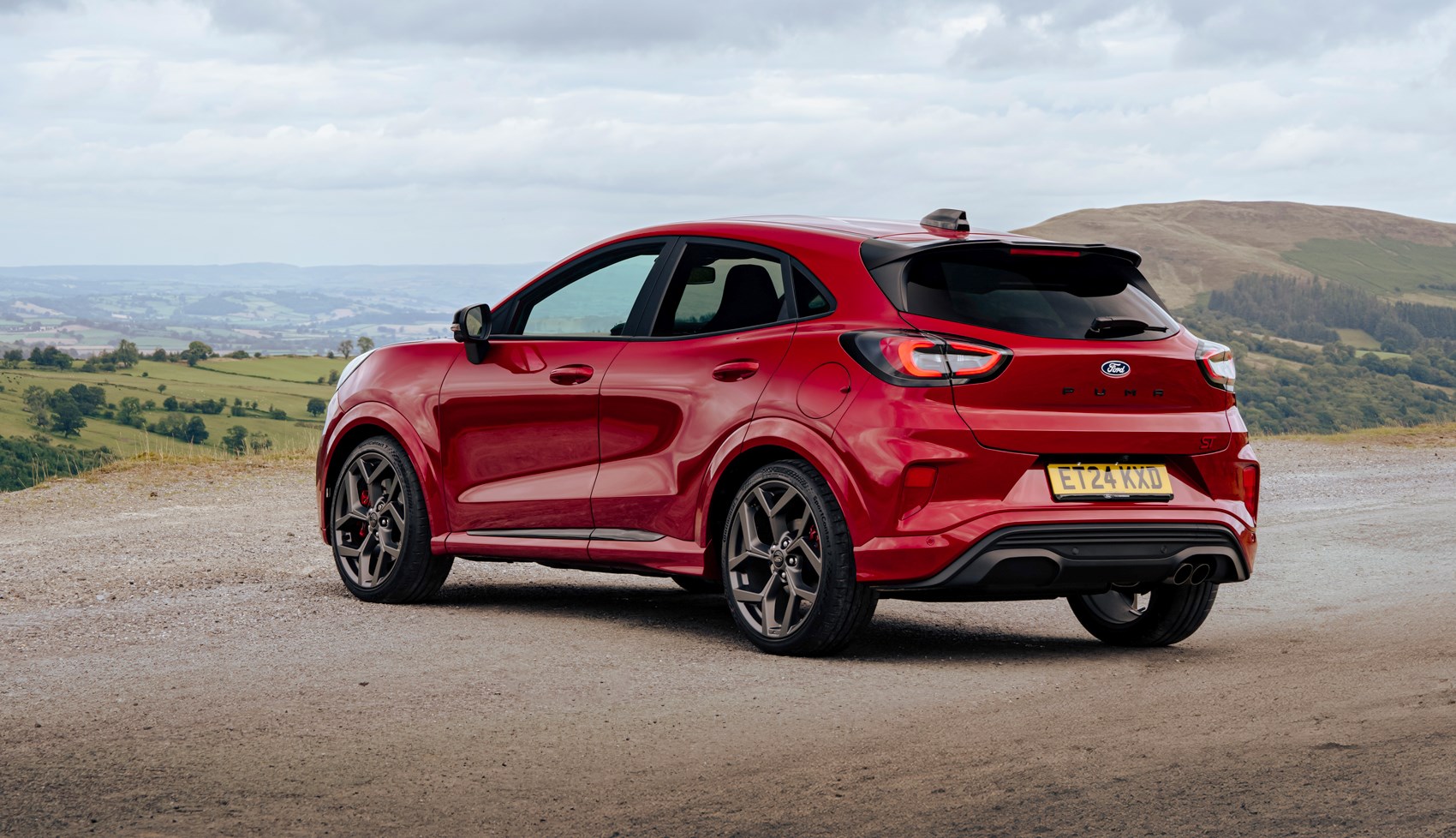
Every Puma model now features some kind of mild hybrid assistance at a minimum, including this Puma ST. That said, this powertrain version of the Puma ST isn’t new; the pre-facelift version also had this engine and gearbox combination for over a year before the facelift arrived.
What are the specs?
Your only choice of Puma ST now is a 1.0-litre three-cylinder turbo developing 168bhp and a total of 183lb ft of combined torque from the engine and the now-standard mild hybrid e-boost on board, mated to a seven-speed dual-clutch ‘Powershift’ transmission. Ford claims a 7.4sec 0-62mph time and a top speed of 124mph.
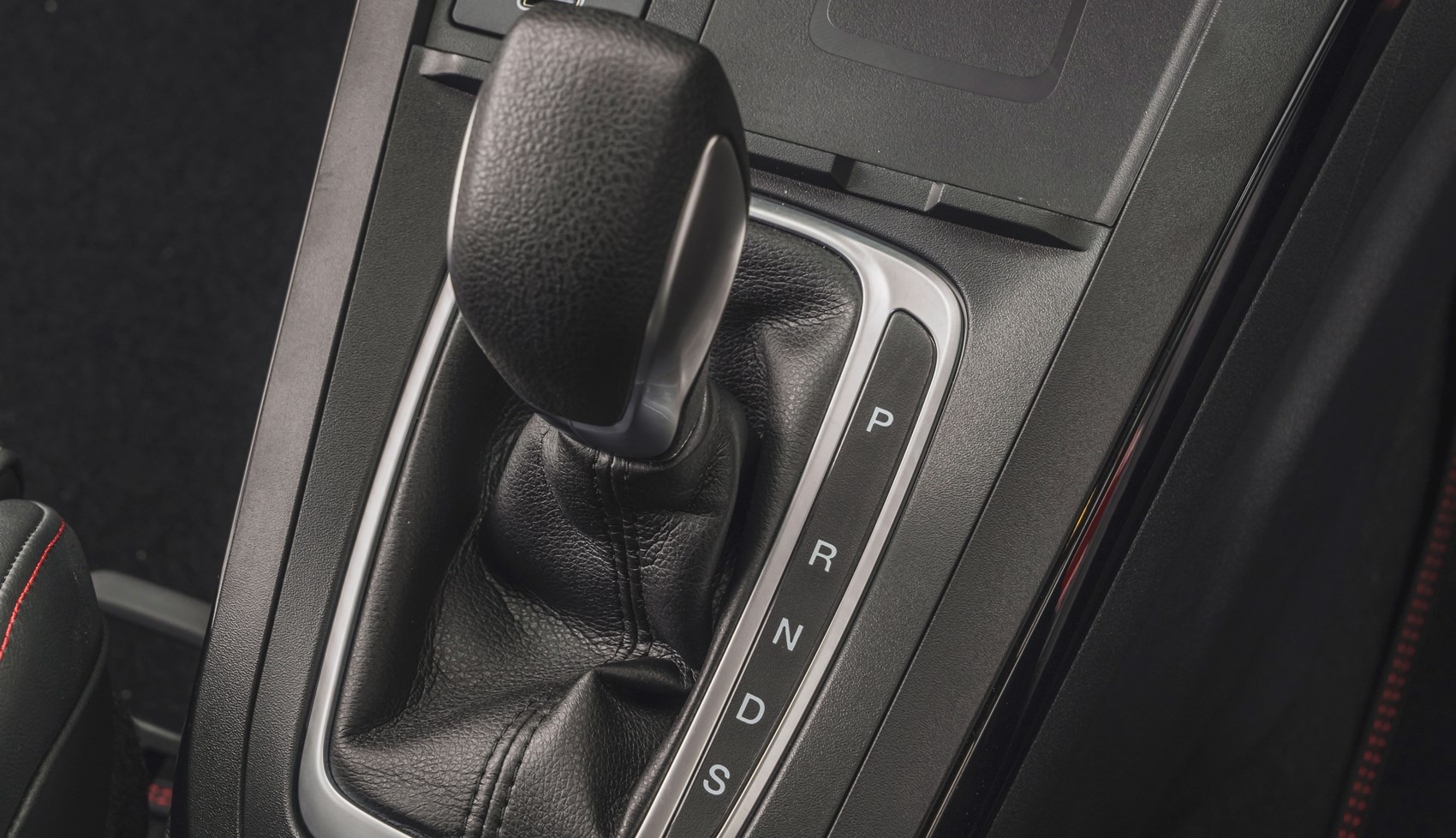
Which is a shame, given the original Puma ST’s powertrain was the same as the fabulously fizzy Fiesta ST, i.e.: a 197bhp 1.5-litre triple with a brilliant six-speed manual to match. Costs and tightening emissions standards will be to blame for the change in powertrain, but that doesn’t mean we’re happy about it.
Besides the performance, ST models feature their own 19-inch alloy wheels, as well as matrix LED headlights, keyless start and go, powered tailgate, loads of safety tech and Ford Performance seats inside.
You can spec a ‘handling pack’ for £1,050, which includes bespoke alloy wheels, contrast black roof, illuminated front door sills and – most importantly – KW coilovers and a round steering wheel (compared to the Puma’s regular oval-shaped one). Our test car didn’t have this equipped.
What’s it like to drive?
The Puma ST still starts up with a burble, just as a car wearing the ST badge should. The engine may be smaller and less powerful, but Ford has at least got that early bit of theatre right.
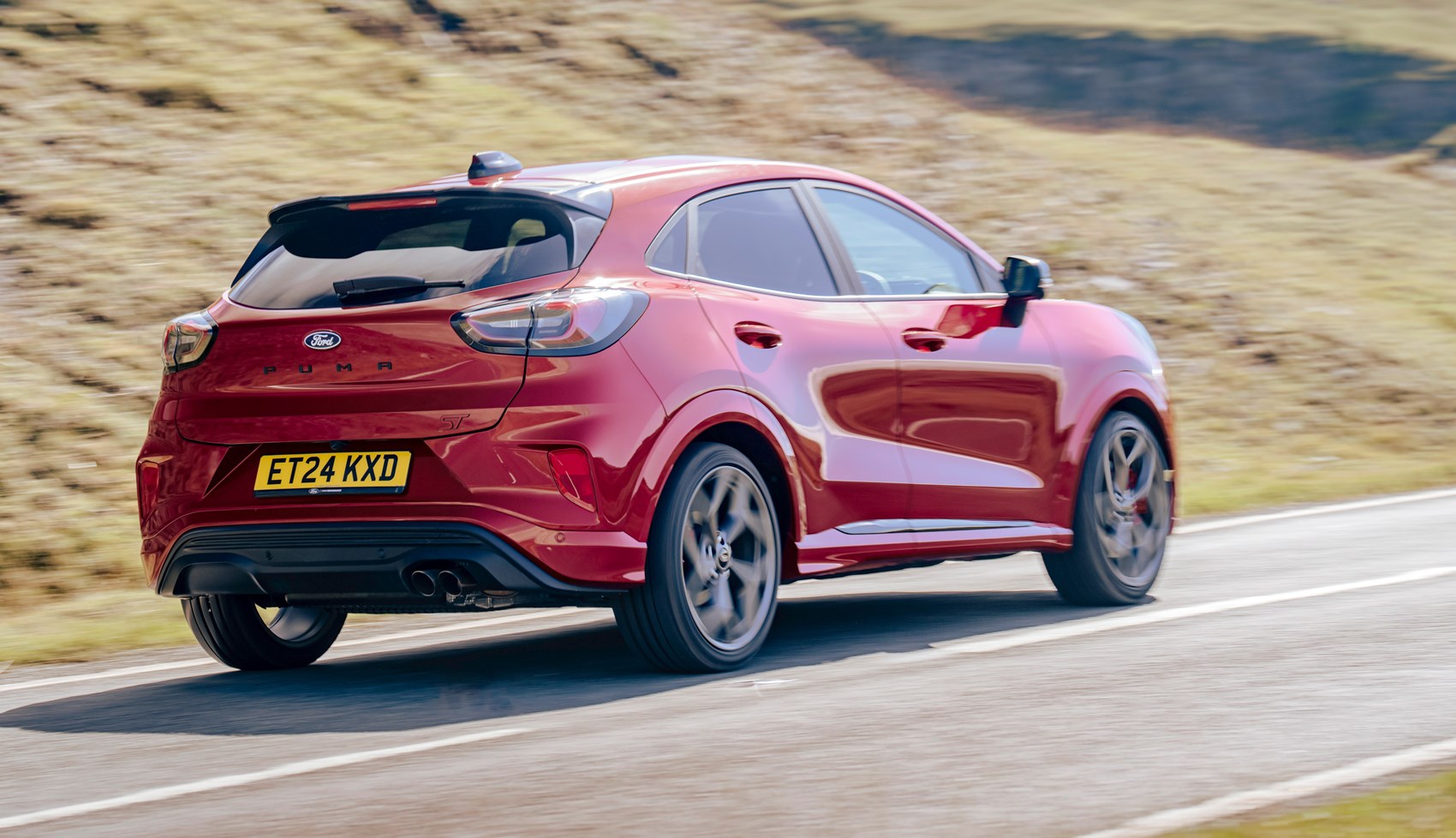
Potter about in town and the Puma ST behaves as well as an ST does, too. The ride is firmly sprung – forever in performance-ready mode – so it’s not the most comfortable thing in the world to nip to the shops in, jittering over ruts and lumps. While the ride settles a smidge at higher motorway speeds, this is still a firmly-sprung SUV.
What impresses, though, is just how sharp and direct the steering is. Even when you’re turning using the weirdly shaped steering wheel, the Puma ST feels alert and ready without being overly twitchy, making zipping across town engaging rather than anodyne.
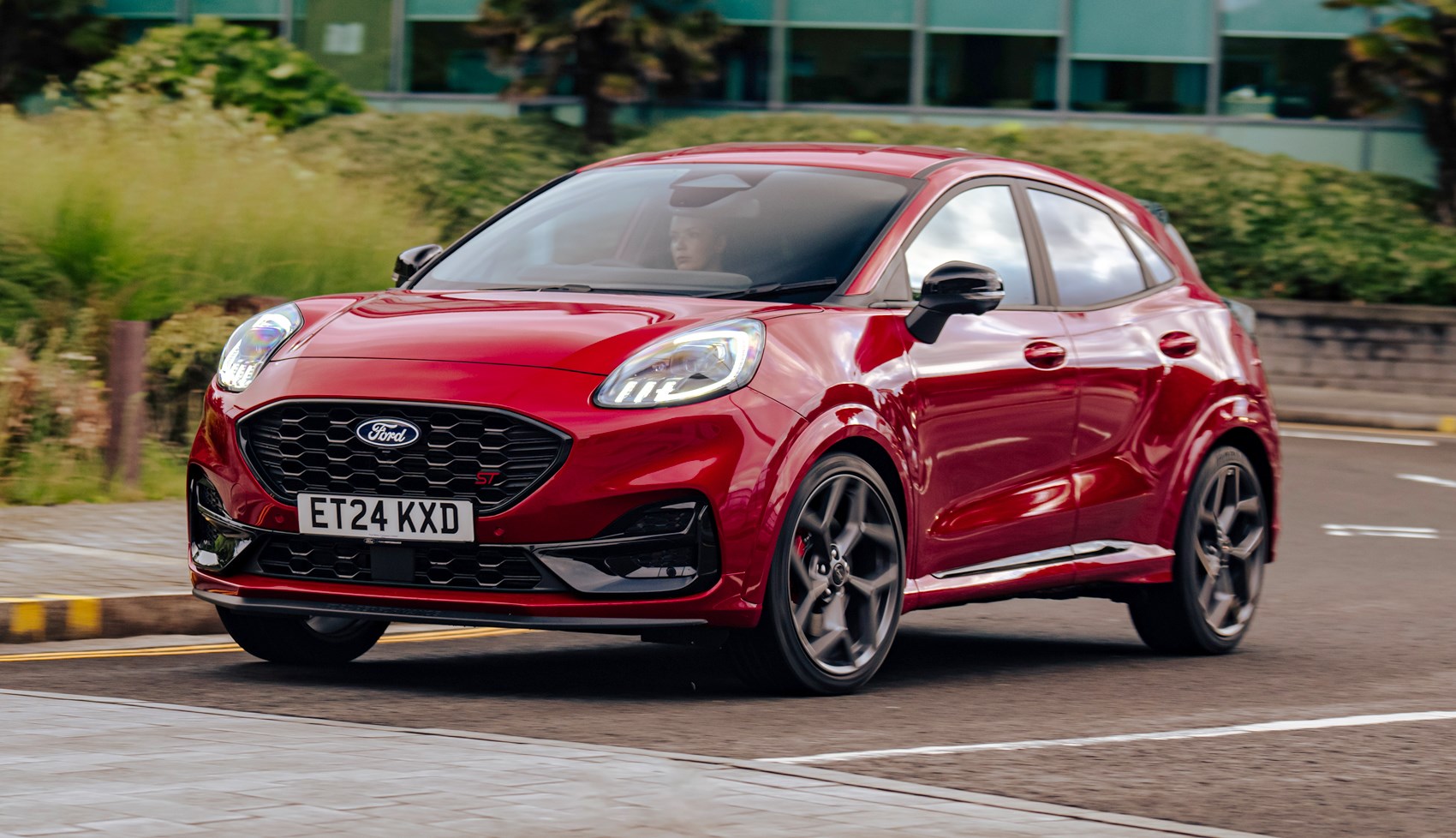
Out of the suburbs is where an ST should really shine. And, in some ways, this Puma ST still does. That sharp steering and firmly-sprung ride make much more sense when out for the hell of it on your favourite B-road, with impressive corner turn-in and body control. But it’s composed, rather than out-and-out fun, gripping neatly and performing admirably.
And then we get to the powertrain. Those on-paper figures suggest a decent power disparity, but Ford Performance engineers have clearly been hard at work masking that difference. Torque in particular feels punchy, with most of the Puma ST’s shove coming in at around 3000rpm; this is very similar to the pre-facelift car with the larger engine, but there’s not much appetite to rev this thing out like a proper hot hatch.
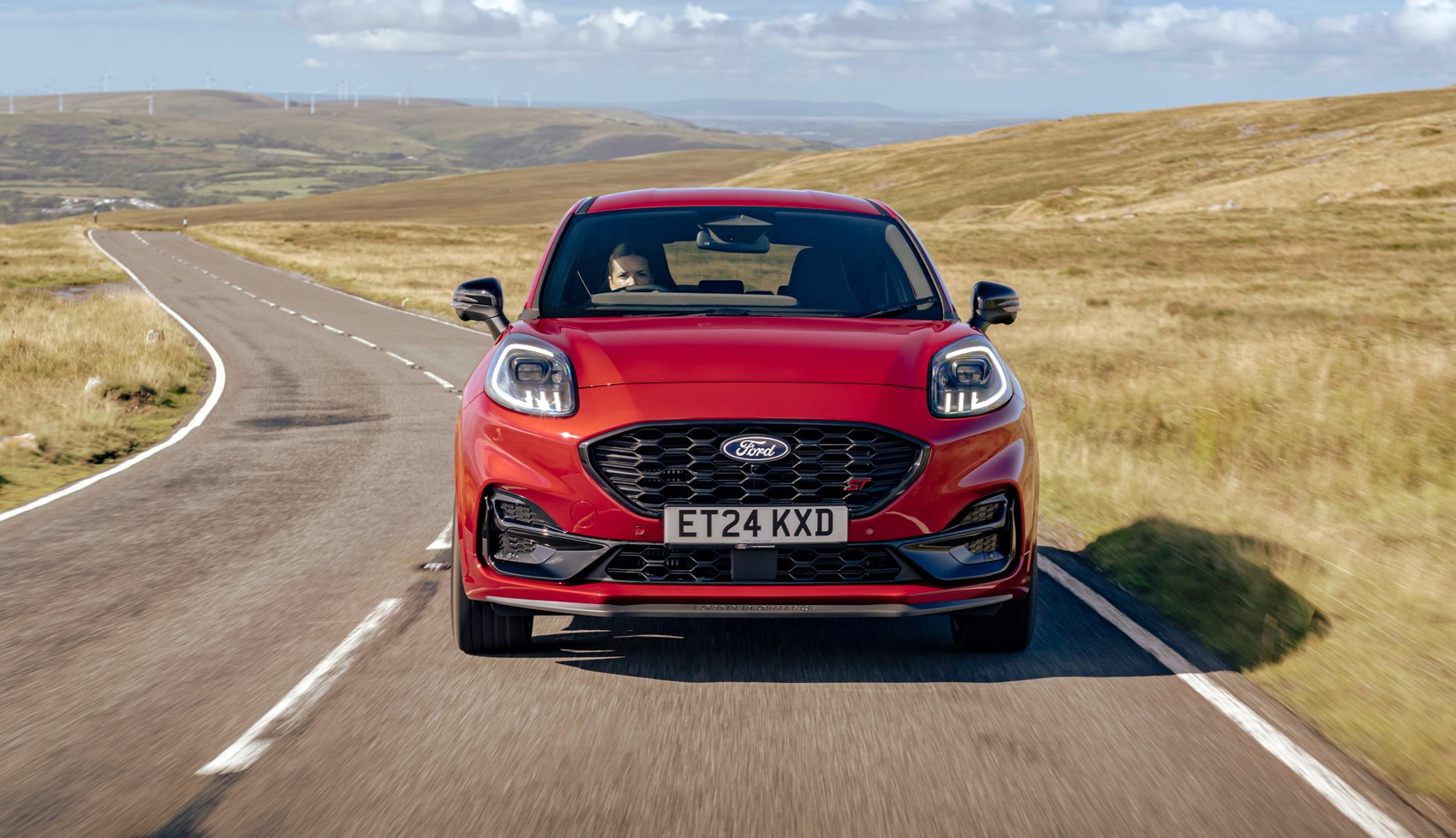
The auto ‘box? It’s… fine, but not great. Given it’s a dual-clutch, it’s responsive at low speeds to acceleration inputs and reasonably reactive to ‘manual’ changes via the plasticky paddles on the steering wheel. But, when pushing hard, I kept wishing for Ford’s fantastic manual transmission here.
There’s still a little bit of the ST’s fizz here but, overall the Puma ST feels like a heavily neutered version of its former self. While it’s still a sweet car to chuck around, the smile on my face was nowhere near as wide as it was with the original manual one.
What’s the interior like?
Like the rest of the Puma range, the ST’s interior has had a major re-do. And, in our opinion, it’s made spending time in one worse. We didn’t like the changes in the regular Puma facelift, and we don’t like them here either.
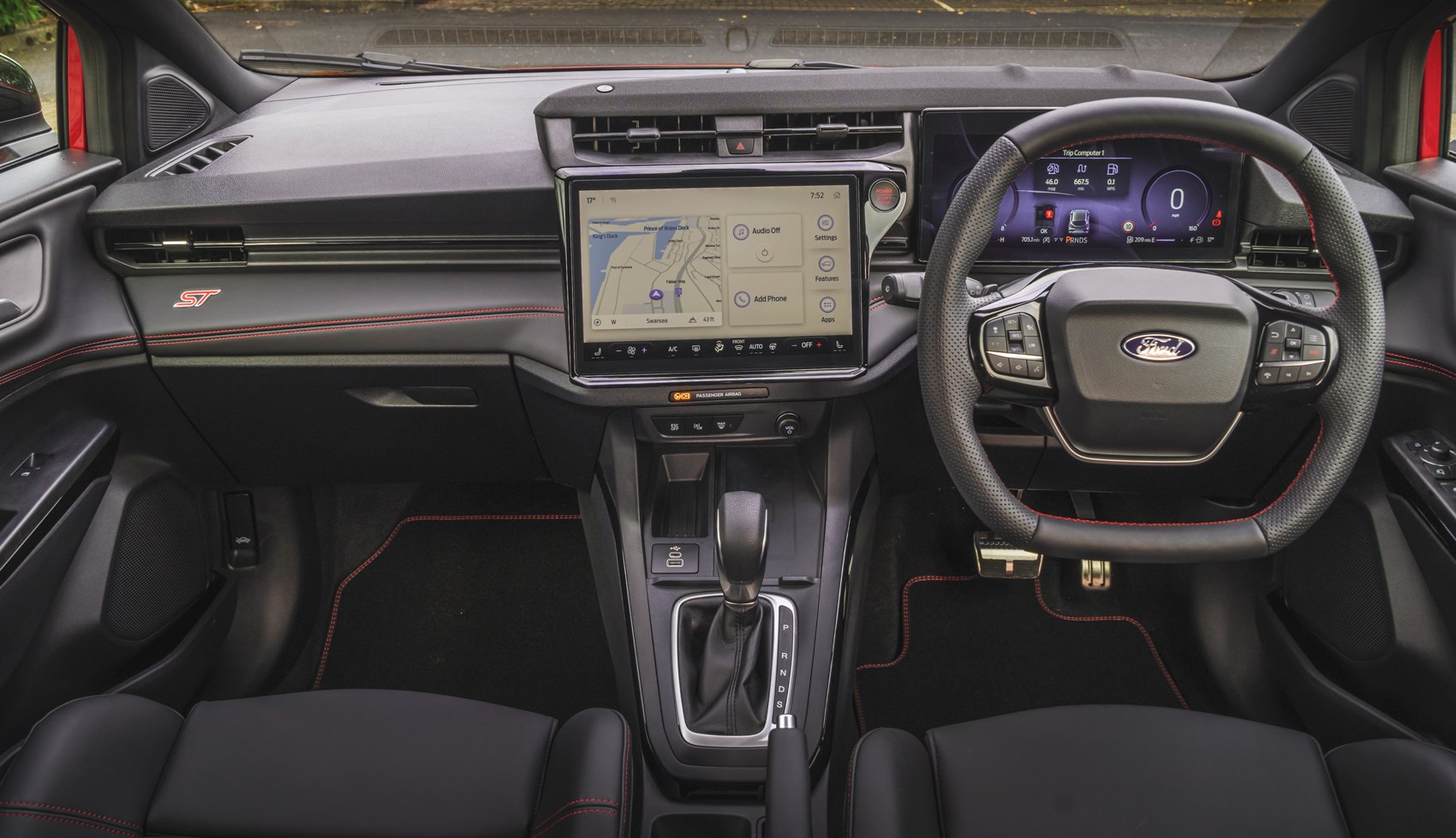
Ford has never really been the last word in interior quality for some time – it’s a criticism that has been levelled at everything from the deceased Fiesta to the regular Puma, larger Focus and Kuga, for example. Some of that is still true, here. The door inserts continue to feel very tinny, the lower centre console is just a sea of naff black plastic and the doors don’t exactly shut with a satisfying whump. It’s more of a clack.
But Ford’s interior were always ones that had solid functionality and some common-sense physical switches.
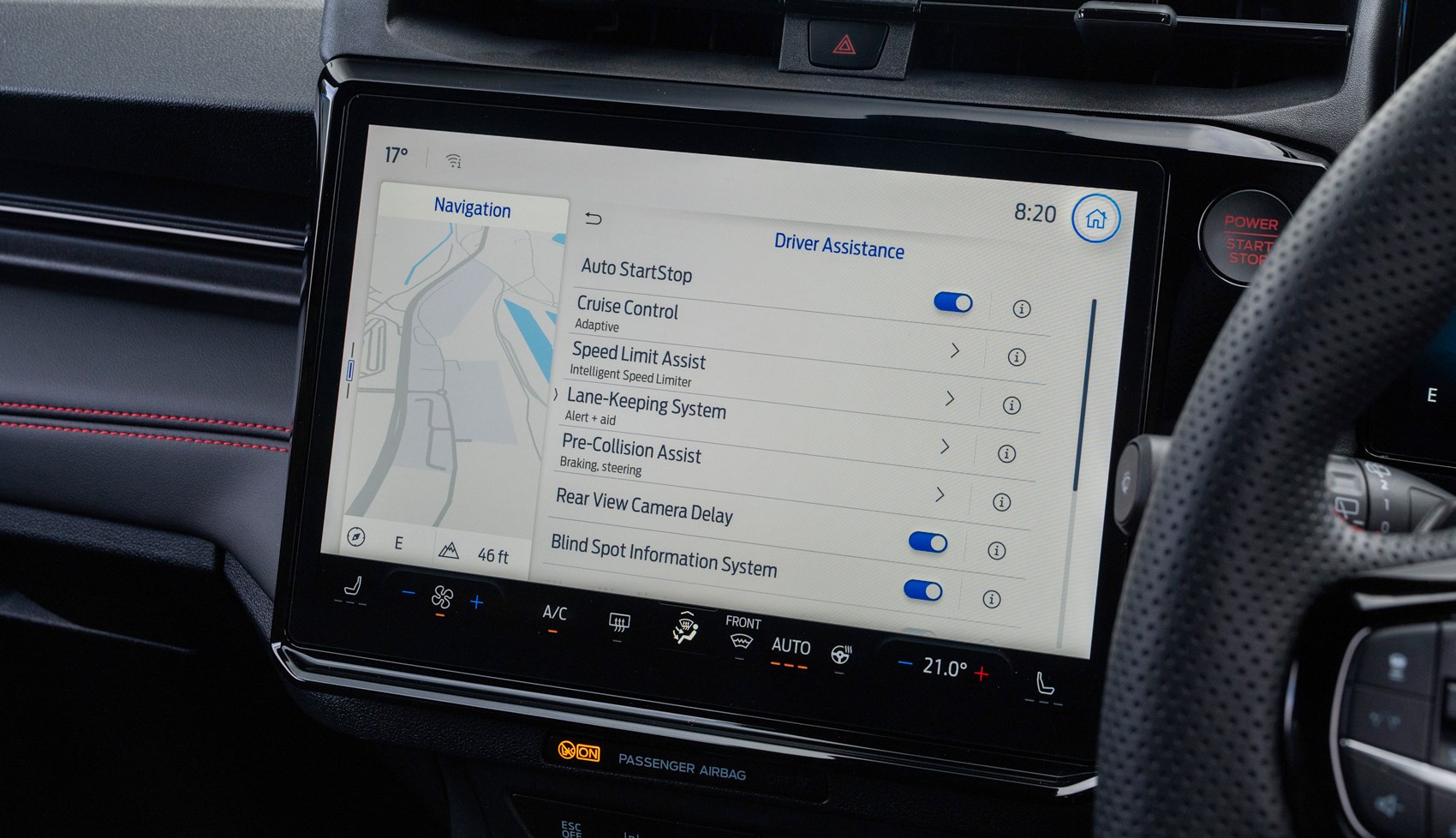
Not here, though. To improve the level of tech on board, Ford has thrown the baby out with the bathwater and moved almost everything onto an enormous screen that physically looks out of place in the new dashboard. Ford’s latest infotainment, Sync 4, comes with plenty of functionality and some reason has been applied to the layout – namely the application of a fixed set of climate controls along the bottom – but the system quickly gets menu-heavy when you start digging through it. The oval steering wheel feels weird to use when turning, too.
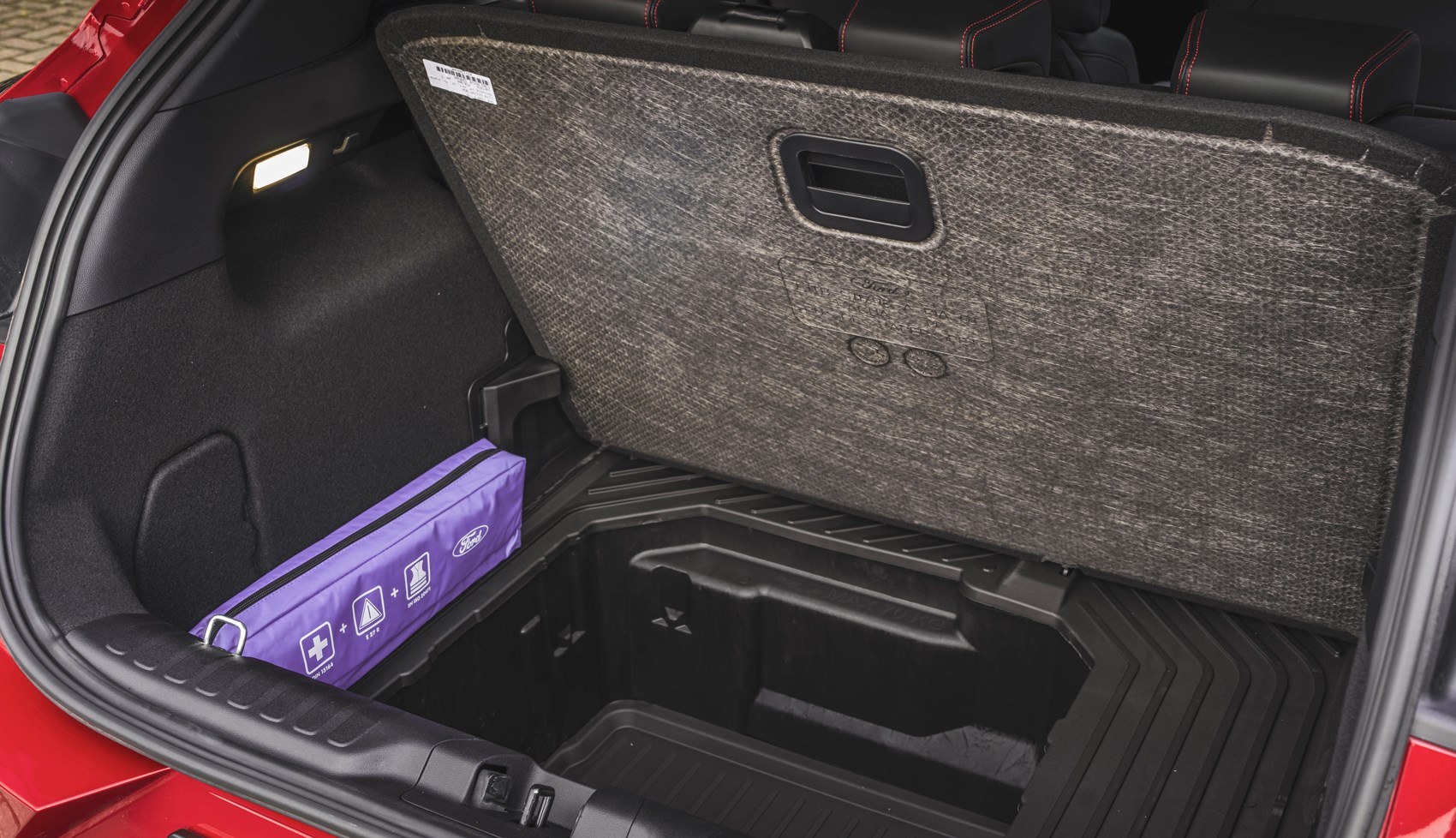
That said, the Puma ST still has some plus points. Rear space is good enough for adults to last more than five minutes back there, with acceptable legroom and good headroom. And the boot space is impressive, helped by Ford’s handy MegaBox load area below the boot floor.
Before you buy
This is, frankly, the Puma ST’s biggest clanger. At the time of writing in January 2025, a Puma ST is on sale for £33,600. That’s before any colours or options are chosen that would add even more to the price. Around £34k for a 168bhp ‘hot’ small SUV is, to our mind, utterly absurd – especially since the price has jumped from its already punchy £28,495 list price pre-facelift.
Yes, we fully acknowledge that cars have gotten more expensive over the last few years as inflation and the cost of manufacturing materials has risen enormously. But this feels like a particularly strong outlier, to the point it makes us wonder why you’d bother looking at one at all.
The flipside is that attractive financing deals (at the time of writing) on one can be had for £300pm, at least making one of Ford’s weakest cars to wear the ST badge at least somewhat affordable.
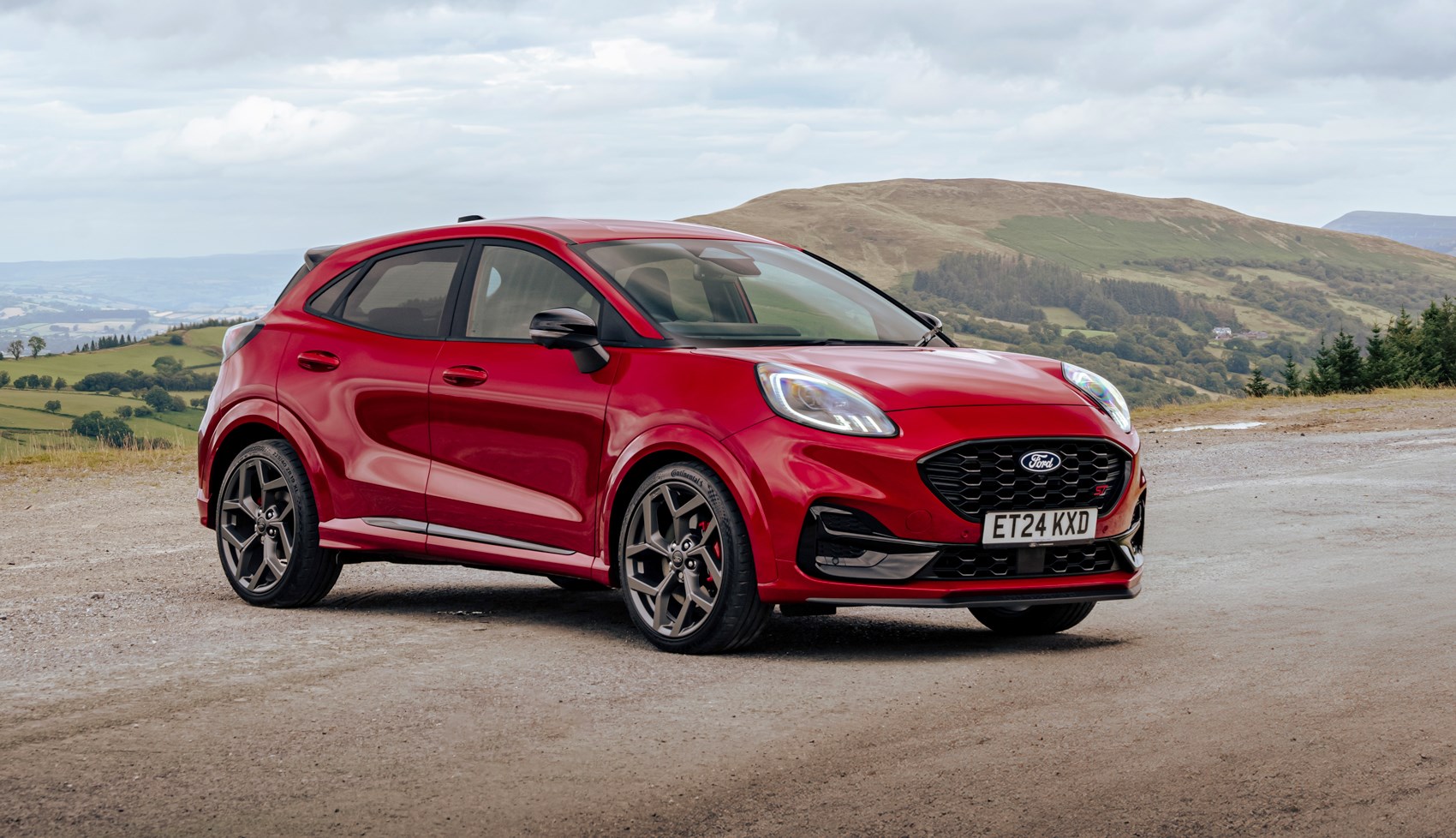
But the pocket rocket scene isn’t what it used to be. Ford’s own Fiests ST is dead, and the Hyundai Kona N – arguably the Puma ST’s closest SUV competitor – kicked the bucket a while back, too. There’s never been a Vauxhall Mokka VXR or Peugeot 2008 GTi to suggest as a crossover alternative either.
Given the Puma ST’s wild price, cars like the bigger Focus ST and Volkswagen Golf GTI seem way more appealing for not a lot more cash or similar financing deal. We’d strongly recommend looking at either of those, instead of sinking so much money (or an unwise finance deal) on a new Puma ST. If you’re totally set on a small, spicy Ford, go look at used Fiesta STs instead.
Verdict: Ford Puma ST auto
The latest Puma ST is still a sweet handling thing, with Ford Performance engineers doing a commendable job of masking the power deficit. From a usability perspective, the hot Puma still offers a good amount of space inside and a big boot. These details are the reason the Puma ST doesn’t dip lower than three stars in our verdict.
But the whole point of a facelift, particularly for a car as successful as the Puma, is that it should refine details, improve technology and fix problems.
Post-facelift, the Puma ST now is a slower, less fun, less user-friendly and cheaper-feeling car than it was before. And yet it’s one that’s demanding a huge amount more money for the privilege of being on your driveway.
It feels like Ford doesn’t actually want you to buy one by making it so expensive. So, don’t bother.